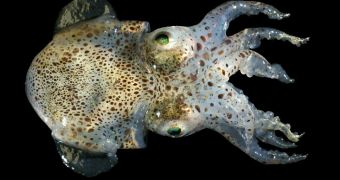A particular squid species has captured the attention of researchers, due to the variety of methods it uses to steer clear of predators. The animals is part of the cephalopods group, which includes cuttlefish, squids and octopus.
All these creatures are capable to protecting themselves from predators through a variety of means, but some of them are more inventive than others, researchers say. The Hawaiian bobtail squid is a good example of this.
Like all creatures of its type, it too relies on camouflage as its main defense against predators. The animal generally buries itself in sand at the bottom of the sea, and awaits for night there.
If they are disturbed while doing so, or forced to move to land, they also carry sand with them, and then try to be as still as possible, to avoid capturing the attention of other animals.
“During the day, if they are disturbed from the sand, they will come out, sit on the surface with a sand coat on them, trying to be invisible,” explains University of Wisconsin-Madison (UWM) professor of medical microbiology and immunology Margaret McFall-Ngai.
“And, if that doesn’t work, they will eject ink. They themselves turn completely white, as transparent as they can be, and leave behind that blob of ink in the same size as they are,” she adds.
The investigator is also the leader of a team that is now using funds secured from the US National Science Foundation (NSF) to look into yet another defense mechanism this particular species has, namely the ability to glow in the dark, or to be luminescent.
The squid does not produce light by itself. Instead, it developed a symbiosis relationship with Vibrio fischeri, a type of bacteria that is capable of bioluminescence. But this relationship does have its ups and down, experts found.
“The squid emit ventral luminescence that is often very, very close to the quality of light coming from the moon and stars at night,” McFall-Ngai says, explaining that the bacteria only hang on to the squid at night.
This confuses predators lurking at depth, who scan waters just underneath the surface for potential prey. To them, the squid looks as either the Moon or some star, because it doesn't cast a shadow. As such, they leave it alone.
In the morning, the bacteria separate from their host, when the light of dawn falls on them. The squid then goes to hide in the sand, where a new generation of bacteria develops on its belly until nightfall, when the cycle begins anew.
“The bacteria live inside the squid, but they don't live inside the squid's cells. So you have this sort of cave, this kind of nest that the squid makes for the bacteria,” concludes graduate research assistant Elizabeth Heath-Heckman.

 14 DAY TRIAL //
14 DAY TRIAL //